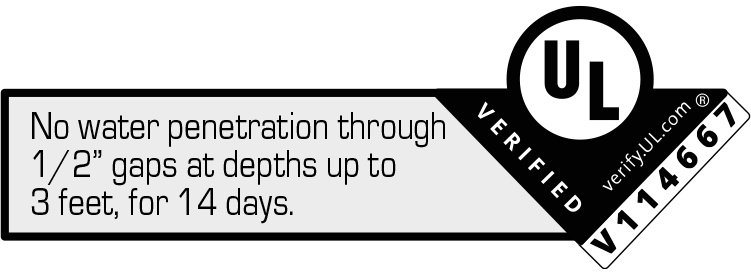GET IT FAST! THIS ITEM QUALIFIES FOR EXPEDITED SHIPPING.
The Flex Seal Family of Flood Protection Products are specifically designed to work TOGETHER to create multiple layers of super-strong, waterproof protection, and to be easily removed after floodwaters recede. They can help slow down or even stop water from entering structures.
Home Flood Protection Bundle — one product, two size selections. Choose the bundle that fits your job size and application method.
BUNDLE OPTIONS
Standard Bundle
Includes TWO 9 oz cartridges of Flood Protection Paste (caulking gun required) and ONE 1-Gallon container of Flood Protection Liquid.
How it’s used: Apply Flood Protection Paste as a base coat to fill gaps and seams. Brush Flood Protection Liquid over the dried Paste (or other Flood Protection products) as a final coat to help seal small pinholes or missed openings.
Large (MAX) Bundle
Includes TWO 28 oz cartridges of Flood Protection Paste MAX (XL caulking gun required) and ONE 320 fl oz container of Flood Protection Liquid MAX.
How it’s used: Same system as Standard, scaled up for larger coverage and wider beads.
SYSTEM BENEFITS
Flood Protection Paste is the primary product and should be used as a base coat for your first layer of protection. It starts out as a thick paste that can be pushed deep into openings and hard-to-reach areas, then dries to a strong, flexible, rubberized barrier that seals out water, air, and moisture. Flood Protection Liquid is brushed on top as a final coat to help seal small pinholes or missed spots.
For complete instructions, visit flexsealproducts.com/flood.
 WARNING: California Proposition 65 Notice.
WARNING: California Proposition 65 Notice.

We’re proud to say that when used in combination, and as directed, our Flood Protection Products have been independently verified by UL Solutions to hold back 3 ft of water for 14 days on gaps up to ½ inch. Tested in laboratory settings.
Patent Pending for Products and Uses.
DRY TIME
Depending on temperature, humidity, and thickness of application, Flood Protection Paste will dry to the touch in approximately 2–6 hours and fully cure in approximately 24–48 hours. Allow products to fully cure before floodwaters arrive. Flood Paste begins to cure when exposed to air; remove any dried material and always use fresh material to seal an opening.
COVERAGE (GUIDANCE)
Cartridge Bead Coverage (¼" bead):
9 oz Paste Cartridge: approx. 21 linear feet.
28 oz Paste MAX Cartridge: approx. 62 linear feet.
IMPORTANT INFORMATION
Always follow state and local weather advisories and evacuation orders. Depending on age and type of construction, there may be areas that cannot be seen or sealed. Unsealed porous surfaces may seep water during extended underwater exposure. Flood Protection Products are NOT intended for flash floods, extreme winds or water pressure, to protect against flying or floating debris, or where there is structural damage to the building.
How To Use Flood Protection Paste (Cartridge)
For instructions on how to seal doors, windows, electrical outlets and other areas around your home or business, visit: flexsealproducts.com/flood
Read entire label for directions and warnings before use.
• Protective gloves, clothing, andeyewear are recommended.
• Apply to the exterior of the structure.
• Area being sealed must be clean, dry, and free of grease, oil, and dirt.
• Unscrew nozzle, cut the nub on the cartridge, being careful not cut or damage threads.
• Screw nozzle back on cartridge and cut nozzle to the desired thickness of the bead.
• Place the cartridge into a caulking gun.
• Using a smooth motion, apply an even bead directly to the areas being sealed.
• Use your finger or tool to push the bead into the surface being sealed. (Gloves recommended)
• Apply additional coats after 2-6 hours or when dry to the touch.
• Additional coats should overlap and be wider than previous coats.
• Material can be tooled for approximately 10 to 15 minutes before curing begins.
• Allow approximately 24 to 48 hours to fully cure before floodwaters arrive.
REMOVAL
Grab a small portion of material from an edge and pull away from the structure. Using a small pair of pliers may be necessary. If any residue is left on the surface, use a stiff nylon brush, paper towel or rag with denatured alcohol to clean the area.


























